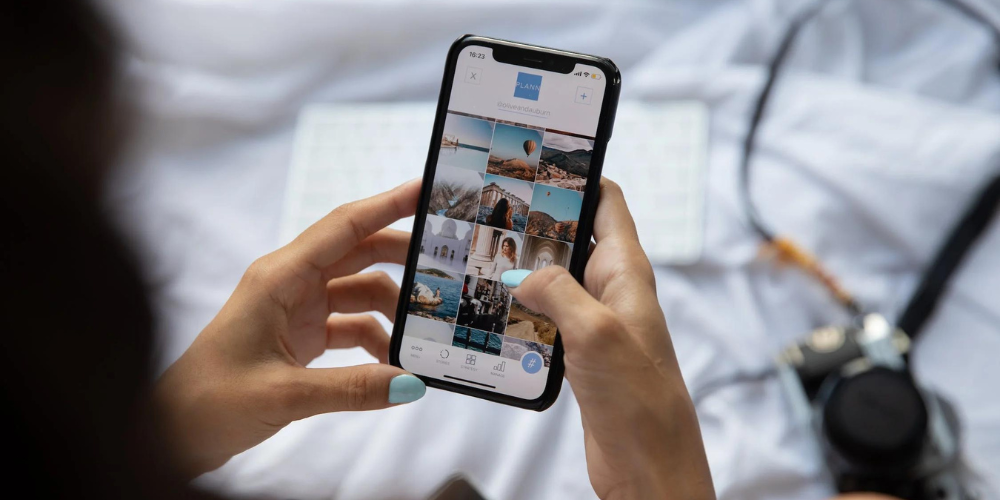
First, model Hailey Bieber wore nude nails with a chrome finish, and “Glazed Donut Nails” were born. Then actual naked nails, which involved literally not wearing nail polish at all, became a thing. By the time Blueberry Milk Nails rolled around on Tik Tok — after singer-songwriter Dua Lipa shared a photo of herself wearing a pale blue manicure in June — some people had enough.
Critics are calling out these types of social media trends because they’re supporting a repackaged presentation of a product that already exists, e.g., pastel blue nail polish. In other words, a product has been renamed (i.e., re-marketed) to appeal to a younger audience and leverage the fact many are swayed by what celebrities/influencers are posting on social media.
Which begs the question: is Generation Z, who has been surrounded by digital technology since birth, suffering an identity crisis because they’re constantly trying to fit an online persona?
We dig into the issue in this article. First up:

Social Comparison In Social Media Trends
People can be easily influenced by social media. Instead of developing their own identity, they try to make themselves fit an online persona. Why? Social psychology theories may have an answer.
Long before Gen Z, in 1954, psychologist Leon Festinger introduced the social comparison theory. This concept suggests that people value their own personal and social worth by assessing how they compare themselves to others.
And posting on social media is one way to gain validation. Quantifiable feedback, such as the number of “likes” or positive comments on a post, only reinforce these ideals, one study reports.
Social Identity In Social Media Trends
Then in the 1970s, two other social psychologists, John Turner and Henri Tajfel, developed the social identity theory. This idea has to do with a person’s self-concept, acquired from their membership in social groups.
When applied to fashion and pop-culture trends, the social identity theory could explain why consumers follow trends set by celebrities and influencers. Those individuals are perceived as being liked and superior, so, you could argue that by following their trends, the follower is making himself or herself more likeable, as well.
Another reason why people follow trends is because it works as a mental shortcut. Following what others are doing, it shortens and eases the thought process — it eliminates the struggle of making a decision, for example.
It’s not that trends (or more specifically, conformity) are a bad thing. They can create a herd mentality, which gives people a sense of unity and consensus with one another. It makes people feel like they belong, and are accepted, by their group. Humans are social creatures, after all.

Consequences Of Social Media Trends
While there are positive aspects to conformity, as we just mentioned, the downside is it can lead people to suppress their individuality and affect their ability to think critically.
Excessive comparison to others on social media can also have a detrimental effect on body image, sense of self-worth, identity development, and mental health. This is because ideal representations of celebrities can lead social media users to compare themselves to a carefully chosen image, and to compete with others as they try to show off their lives as perfectly as possible.
So Is Gen Z Suffering An Identity Crisis?
One defining attribute of Gen Z is it attaches great importance to self-image, and yes, social media may have something to do with that, one report suggests. That may not necessarily mean they’re struggling with individuality, however.
One study points to research that shows Gen Z is more open to diversity and is more individualistic and technology-driven than other generations. We’re guessing this might be because they’re actually quite aware of the huge amount of social media trends that constantly pop up, and the fact they can beget conformity. As a result, Gen Z may be quite conscious about maintaining their individuality.
So is this younger demographic suffering an identity crisis? It’s hard to tell for sure.

How To Maintain Your Uniqueness In The Social Media Space
By all means, follow a trend you find fun, who are we to behoove anyone’s enjoyment? At the same time, you can help yourself stay true to yourself by remembering a few things:
1. People tend to present a curated (and edited or filtered) version of themselves online.
2. Products are made, marketed, and advertised to sell. Cutesy names such as “Blueberry Milk” are designed to draw you in. Take a step back at look at a product for what it really is, e.g., pastel blue nail polish. That’s it.
3. Marketing is designed to appeal to your emotions, so you connect with the product and will likely continue to use (and buy) it.
4. Social media platforms are designed to encourage users to conform to their algorithms. They prioritize content that’s viral, or popular, and align with a user’s previous behaviour. So users are more likely to see posts and ads that match what they value, rather than being shown content that features different perspectives.
So why not just be you, with or without Blueberry Milk Nails? Be your own influencer. Let yourself decide what nail polish (or anything else) you really want to wear, when to wear it, and how to wear it. There’s individuality in that.
Disclosure: We are a professional review and product rating website and mobile app that receives compensation from the companies whose products we review and rate. We are independently owned and the opinions expressed here are our own interpretations of a trusted source.
Blueberry Milk Nails Might Be Fuelling A Gen Z Identity Crisis was originally published in Think Dirty on Medium, where people are continuing the conversation by highlighting and responding to this story.